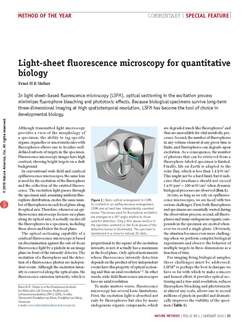News
Light sheet-based fluorescence microscopy is the Nature Method of the Year 2014
January 2015. Light-sheet fluorescence microscopy (LSFM, SPIM, DSLM) enables relatively gentle imaging of biological samples with high resolution in three dimensions and over long periods of time. Especially when combined with high-speed cameras, it is fast enough to capture cellular or subcellular dynamics. For its potential for fast, relatively gentle, volumetric imaging of biological samples, light-sheet fluorescence microscopy was chosen as Nature Method of the Year 2014.
Overcoming the limitations of confocal fluorescence microscopy, Ernst Stelzer and his group invented and developed light sheet-based fluorescence microscopy establishing it as a major tool in the modern life sciences. Instead of illuminating or scanning the whole sample through the imaging objective, this new microscopy method illuminates the sample from the side with a thin sheet of light. The emitted fluorescence is then detected from above or below the sample, along an axis perpendicular to the light sheet. Thus only the molecules at or near the focal plane are excited, causing lower phototoxicity and yielding an improved ability to image living samples over time. The technology requires an interdisciplinary research team and its success in imaging biological specimen rests on the development of genetically encoded fluorescent proteins and the availability of labeled transgenic organisms.
Light sheet-based fluorescence microscopy has become the tool of hoice in developmental biology. This technology is poised to give scientists new vistas into biological systems in ways that were not thought possible before.
A series of papers by Ernst Stelzer and some of his former Ph.D. students and postdocs in the latest issue of Nature Methods discuss how this technology, in combination with increasingly sophisticated cameras and powerful computing, is dramatically changing and enabling the imaging of living biological samples from developing embryos to functioning brains. More...
Contact
Ernst Stelzer
Buchmann Institute for Molecular Life Sciences
Institute of Cell Biology and Neuroscience
Goethe University Frankfurt
60438 Frankfurt am Main, Germany
ernst.stelzer@physikalischebiologie.de


